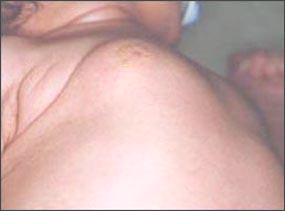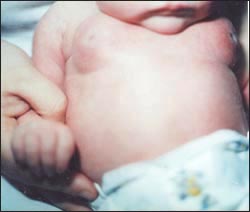남아 여성형 유방증, Gynecomastia
남아 여성형 유방증의 원인
- 자궁 속 태아는 모체로부터 에스트로겐 등 여러 종류의 호르몬을 공급받는다.
- 태아가 모체로부터 공급받았던 모체의 성호르몬으로 신생 남아들의 한쪽 유방 또는 양쪽 유방이 일시적으로 정상 이상으로 커질 수 있다.
- 이렇게 커진 신생 남아 유방은 생후 3~4주 지나면 거의 정상 크기로 돌아가는 것이 보통이다.
- 말기 학령기 남아들에게 사춘기가 시작될 때 남아 신체 내에서 분비되는 에스트라디올 여성 호르몬과 남성호르몬 테스토스테론(Testosterone) 호르몬의 영향으로 남아의 한쪽 또는 양쪽 유방이 여성형 유방 비스름하게 발육 될 수 있다.
- 이렇게 남아들에게 사춘기가 올 때 생긴 여성형 유방을 청소년기 여성형 유방 또는 여성형 유방이라 한다.
- 사춘기 기간 동안 사춘기 남아들의 40~70%에게 청소년기 여성형 유방이 생긴다.
- 청소년기 여성형 유방은 치료를 하지 않아도 생긴 후 2년 이내에 75%가, 3년 이내에 90%가 없어진다.
- 어떤 남아들의 유방은 다른 남아들의 유방보다 자신의 체내에서 분비되는 여성 호르몬의 영향에 더 예민하게 반응할 수 있고, 어떤 남아들의 유방은 자신의 체내에서 분비되는 미량의 여성 호르몬에 과민하게 자극 받아 조기에 유방이 발육된다.
- 여성 호르몬 약물을 경구로 섭취하거나 피부에 바르거나, 고환 종양이나 부신 종양이 날 때, 선천성으로 남아들의 유방이 조기 발육될 수 있다.

그림 1-33. 병이 없는 신생아의 유방이 조기발육됐다. 출생 전 모체로부터 받은 여성호르몬으로 인해 생긴다.
Copyright ⓒ 2011 John Sangwon Lee, MD., FAAP

그림 1-32. 병이 없는 신생아의 유방이 조기발육됐다. 출생 전 모체로부터 받은 여성호르몬으로 인해 생긴다.
Copyright ⓒ 2011 John Sangwon Lee, MD., FAAP
남아 여성형 유방증의 증상 징후 진단
- 사춘기 남아들의 40~70%에서 한쪽 유방이나 양쪽 유방이 정상적으로 조금 더 커지면서 여성형 유방이 생길 수 있다.
- 여성형 유방이 처음 얼마동안 은근히 조금 아플 수 있다. 그 후 2개월~ 2년 동안 별다른 증상 징후가 없이 유방만 커져 있을 수 있다.
- 처음 얼마동안 커졌던 상태 그대로 몇 년 동안 계속 있다가 그 후 성인 남성들의 정상적 유방으로 성장 발육되는 것이 보통이다.
- 사춘기 남아들의 유방이 비정상적으로 커져도 젖꼭지는 성인 여성의 젖꼭지 같이 발육되지도 않고 여성형 유륜(유두륜)은 생기지 않는다.
- 드물게, 남아들의 유방이 성인 여성 유방의 크기만큼 비정상적으로 커질 수 있다.
- 이런 유형의 유방이 있는 사춘기 남아는 남들 앞에서 옷 벗기를 싫어하고 정신적 스트레스를 많이 받을 수 있다.
- 병력·증상 징후·진찰소견 등을 종합해서 진단한다.
남아 여성형 유방증의 치료
- 유방 조기 발육으로 커진 신생아의 여성형 유방은 아무 치료 없이 관찰한다.
- 사춘기 남아들의 한쪽이나 양쪽 유방에 여성형 유방이 생겨 많이 고민할 때는 유방 성형수술 치료를 받을 수 있다.
- 사춘기가 시작될 때 한쪽 유방이나 양쪽 유방이 조금 커지면서 아프면 관찰적 치료를 한다.
- 비만한 남아들의 유방이 여성형 유방처럼 클 수 있지만 젖꼭지는 성인 여성들의 젖꼭지처럼 커지지 않는다.
- 비만증을 치료하면 커진 유방이 정상적으로 돌아간다.
- 다른 원인으로 유방이 비정상적으로 커졌을 때는 그 원인에 따라 치료한다.
Gynecomastia in boys
Causes of Gynecomastia in Boys
• The fetus in the womb receives various hormones, including estrogen, from the mother.
• One or both breasts of newborn boys may temporarily enlarge beyond normal due to maternal sex hormones that the fetus received from the mother.
• It is normal for newborn boys’ breasts to return to their normal size after 3 to 4 weeks after birth.
• In late school-age boys, estradiol and testosterone, which are secreted in the male body at the beginning of puberty, may cause one or both breasts to develop as gynecomastia.
• Gynecomastia that occurs when boys reach puberty is called adolescent gynecomastia or gynecomastia.
• During puberty, 40-70% of adolescent boys develop adolescent gynecomastia.
• Adolescent gynecomastia disappears 75% within 2 years and 90% within 3 years without treatment.
• Some boys’ breasts may react more sensitively to the effects of female hormones secreted in their body than other boys’ breasts, and some boys’ breasts are overstimulated by trace amounts of female hormones secreted by their body. Breasts develop early.
• When female hormone drugs are taken orally or applied to the skin, or when a testicular or adrenal tumor develops, it is congenital that boys’ breasts may develop prematurely.

Figure 1-33. Breasts of infants without disease developed prematurely. It is caused by female hormones received from the mother before birth. Copyright ⓒ 2011 John Sangwon Lee, MD., FAAP

Figure 1-32. Breasts of infants without disease developed prematurely. It is caused by female hormones received from the mother before birth. Copyright ⓒ 2011 John Sangwon Lee, MD., FAAP Diagnosis of symptoms of gynecomastia in boys
• In 40 to 70% of adolescent boys, gynecomastia may develop as one or both breasts normally grow slightly larger.
• Gynecomastia can be mildly painful during the first few days. After that, for 2 months to 2 years, there may be no symptoms and only the breasts may be enlarged.
• It is normal for the breast to grow and develop into normal adult male breasts after continuing for several years as it initially grew.
• Even if the breasts of adolescent boys grow abnormally, the nipples do not develop like the nipples of adult women, and gynecomastia (areola) does not occur.
• Rarely, a boy’s breast can become abnormally large as large as an adult female’s breast. • Adolescent boys with this type of breast are reluctant to take off their clothes in front of others and can be psychologically stressful.
• Diagnosis is made by combining medical history, symptoms, signs, and examination findings. Treatment of male gynecomastia
• Gynecomastia in newborns who have enlarged due to premature breast development should be observed without any treatment.
• When adolescent boys have gynecomastia on one or both breasts and are very worried, they can receive plastic surgery treatment.
• At the beginning of puberty, if one or both breasts enlarge slightly and become painful, observe treatment.
• Although obese boys’ breasts can be as large as gynecomastia, their nipples do not grow as large as adult women’s nipples.
• When obesity is treated, enlarged breasts return to normal.
• If the breast is abnormally enlarged due to other causes, treat it according to the cause.
출처 및 참조 문헌 Sources and references
- NelsonTextbook of Pediatrics 22ND Ed
- The Harriet Lane Handbook 22ND Ed
- Growth and development of the children
- Red Book 32nd Ed 2021-2024
- Neonatal Resuscitation, American Academy of Pediatrics
-
The Johns Hopkins Hospital, The Harriet Lane Handbook, 18th& 19th edition
-
Red book 29th edition 2012
-
Nelson Text Book of Pediatrics 19th Edition
-
Emergency Pediatrics A Guide to Ambulatory Care, Roger M. Barkin, Peter Rosen
-
Ambulatory Pediatrics, Green and Haggerty, Saunders
-
School Health: A guide For Health Professionals, American Academy of Pediatrics
-
How to really love your child Ross Campbell
-
Good Behavior Stephen W. Garber, Ph.D. and other
-
Guide to Your Child’s Sleep. American Academy of Pediatrics
-
Hematology and Oncology in Adolescence, Neil J. Grossman, M.D.,
-
Adolescent Medicine and The Media Adolescents Medicine
-
AM:Stars Adolescent Medicine: State of the Art Reviews, Asthma and Diabetes in Adolescents, Robert A. Wood, M.D., Samuel J. Casella, M.D. April 2010, AAP
-
AM:Stars Adolescent Medicine: State of the Art Reviews, Sleep and Sleep Disorders in Adolescents, Amy E. Sass, M.D., MPH, David W. December 2010, AAP
-
The Pediatric Clinics of North America, Adolescent Gynecology, Part II THe Sexually Active Adolescent, August 1999
-
The Pediatric Clinics of North America, Childhood and Adolescent Obesity, August 2001
-
Adolescent Dermatology, Daniel P. Krowchuk, M.D. Adolescent Medicine, 2001
-
Gastrointestinal Disorders, Jeffrey S. Hyams. M.D. Editor, Adolescent Medicine
-
Fueling the Teen Machine, Ellen Shanley and Colleen Thompson
-
Why Teenagers Act the Way They Do, Eight Adolescent Personality Types:Understanding and Dealing With Them, Dr. G. Keith Olson
-
Adolescent Psychiatry, Adolescent Medicine Clinics, Feb. 2006 Richard E. Kreipe, M.D.,
-
Adolescent and the Media, Adolescent Medicine Clinics 2005: Victor C. Strasburger
-
진정한 자녀 사랑 나비게이터
-
10대 아들 딸 이렇게 사랑해 키워라 이상원 역
-
소아과학 대한교과서
-
의학 용어사전 대한 의사 협회
-
제23권 사춘기 아이들 성장 발육 질환 출처 참조 문헌
-
그 외
Copyright ⓒ 2014 John Sangwon Lee, MD., FAAP
“부모도 반의사가 되어야 한다”-내용은 여러분들의 의사로부터 얻은 정보와 진료를 대신할 수 없습니다.
“The information contained in this publication should not be used as a substitute for the medical care and advice of your doctor. There may be variations in treatment that your doctor may recommend based on individual facts and circumstances.
“Parental education is the best medicine.